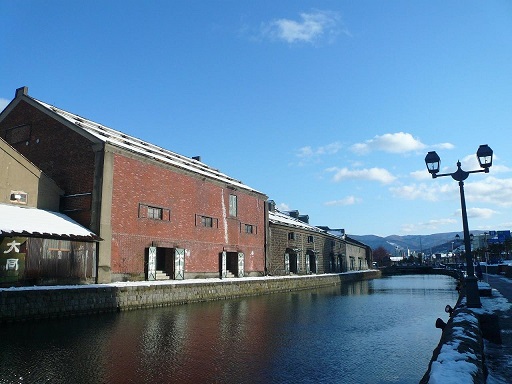|
Otaru Canal and Sakaimachi Historical District

|
Otaru city is located thirty kilometers west of Sapporo.
The name "Otaru" comes from the Ainu language whose natives originally lived in Tohoku and Hokkaido Area.
Otaru was originally developed at the end of the 16th century. The population was around 1,000 at the end of the Edo Age in 1868.
The Otaru Port opened at the end of the Meiji Age
(1868 - 1912)
, and the railroad line was constructed between Horonai, which was the coal-field, and Temiya in Otaru to load coal to ships. As a result, Otaru flourished and the population of Otaru increased to 200,000 at the highest time in the early 1960's.
Otaru Canal
If you walk to east on main street, you will see an old railway track about 200 meters from the station. This was a railroad line from Horonai to Temiya in Otaru, built in 1880.
This line was the third railroad line in Japan. The line was a freight line to carry coal from a coal-field in Horonai to Otaru Port. But, the coal production in Horonai decreased and the line was discontinued in 1985. Approximately thirty years have passed since the railroad line became defunct. But, the original railroad track was maintained in good condition. I felt that a freight train may come on the track. There is a plan to build a new Light Rail Track using the discontinued line. I hope someday, trains will run on the railroad track again.
If you walk further east, you will reach Otaru Canal. You will see red brick and stone warehouses along the canal.
|
|
The above-left photo shows the former Dai-Ichi Bank Otaru Branch, built in 1924. The above-right picture shows the Otaru Branch of Bank of Japan, built in 1912. Otaru Branch of Bank of Japan is now the Bank of Japan Otaru Museum.
The architecture of these bank buildings are stone buildings and well westernized.
To the south of these bank buildings, historical district is located along Sakaimachi Street. This area was a main street in the late 1890s and the beginning of the twentieth century, when Otaru was prosperous. Many store buildings remain along the street.
Many of these store buildings were made of timber framed stone construction. In Japan, buildings with this type of western architecture are not common, so this scenery gives Japanese very exotic atmosphere. Many sightseers also visit this area.
|
|
The picture above-left is the former store of NATORI Takasaburo, built in 1906. The above-right structure is the office building of former Hokkai-Millet Company, built in 1907. These remaining buildings are now used for museums and souvenir shops.
It happened that a carriage passed through. If there were no automobiles behind the carriage, it would have been in the beginning of the twentieth century.
|
|
|
How to get there
To go to Otaru, you will take a JR train from Sapporo. Trains run at every ten to fifteen minutes. It takes approximately 40 to 50 minutes@ from Sapporo to Otaru. Train fare is 640 YEN as of April, 2019.
Otaru Canal and Historical District in Otaru is approximately 15 to 20 minutes on foot.
Other Historical Sites near by:
Yoichi Distillery
Shimo-Yoichi Unjyoke
SapporoClock Tower
Former Hokkaido Government Office
|
|

 Home Page in Japanese: "Shane's HomePage"
Home Page in Japanese: "Shane's HomePage"

 Home Page in Japanese: "Shane's HomePage"
Home Page in Japanese: "Shane's HomePage"